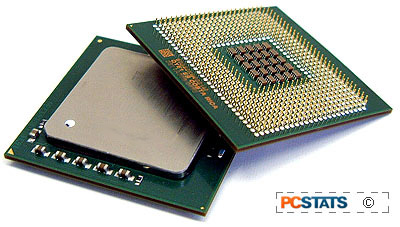Intel introduced the Xeon first in
1998 as a variant of its Pentium II processor architecture intended for the
business server market. Since that point, development of the Xeon line of
processors has shadowed Intel’s mainstream Pentium line of processors. As enhancements are made
to the Pentium, they are generally made to the Xeon as well. For instance, models of
Xeon processor (3.06Ghz) are capable of Hyperthreading just like the technology that
was originally introduced for the Pentium 4s. Let’s take a look at what makes the Xeon
different from its Pentium sibling and examine some of the features of the
latest chip, such as Hyperthreading and the newly introduced Level 3 cache
memory.
 Cache Memory
Cache Memory
Cache memory
is essential for modern processors, and development of ways to bring this memory
closer to the processor have gone hand-in-hand with advances in the speed of the
processors themselves, since raw computing speed is not much use without an
effective system to feed data to the CPU. A modern 32-bit CPU has 8 registers, areas where it can store data internally
while it is being operated on. Each of these registers can hold a single 32-bit value. The registers represent the maximum amount of
data the CPU can reference without needing to access memory.
To expand upon this, every
x86-based processor since the 486 has had some amount of cache memory built into
the processor itself.
This memory, referred to as the level 1 or L1 cache, provides the
processor with an area to store frequently used data close to home. Since the L1 cache
is built into the processor, the time it takes to swap data out of the cache and
into the registers to be operated on is minimal compared with having to send and
retrieve data from the main system memory, which involves transferring it over
system buses that run at a fraction of the speed of the CPU itself.
As most software contains
many instructions that need to be repeated over and over again, the introduction
of L1 cache went hand-in-hand with the increasing speed of processors to make
the graphic interfaces we now take for granted possible. If you’ve ever tried
to run Windows 95 on a 386 machine, you will appreciate the difference that
cache memory made when it was introduced.
As level 1 cache memory was (and continues to be) very
expensive due to the speeds and complexities involved, the amount of memory used
is small compared to system memory, meaning that the processor is still forced
to access main memory more often than is efficient. To combat this, a
level 2 cache was introduced, around the same time the original Pentium
processor was taking hold. Initially this second, considerably
larger area of memory was not built into the CPU itself, since that would have
been prohibitively costly at the time; rather it was built into the motherboard
and accessed via the system bus like the main memory.It was faster than
conventional RAM, and closer to the processor, and therefore more efficient, but
still ran at a fraction of the speed of the L1 cache, though it could hold many
times more data (generally from 128KB to 512KB).
It was obvious that the more high-speed,
easy access memory was available to a given processor, the more efficient that
processor would be, regardless of speed, since it would not have to twiddle its
metaphorical thumbs waiting for data to come down the pipe from main
memory. This finally is where the Xeon came in, or not exactly, but
Intel’s Pentium Pro processor (which can be regarded as the granddaddy of all
server oriented x86 CPUs) was introduced in 1995. It was the first processor to integrate the L2
cache memory into the processor itself, and while the L2 memory was still slower
than the L1 cache, it was capable of holding much more data close at hand,
improving efficiency.
Now we get to the Xeon processor.
The Xeon
Introduced
The first Xeon
was a variant of the Pentium II. Released in 1998, it distinguished itself by
having its 512KB to 2MB of full-speed L2 cache (as opposed to the half-speed
cache used by the PII) built right onto the processor cartridge.
This relatively huge
amount of rapid access memory made the processor very pricey, but also made it a
boon to small businesses hosting websites and databases that saw a lot of data
traffic.
As the Xeon was multi-processor capable, it also became a significant
force in the midrange server market, formerly dominated by non-x86 powered
machines which were considerably more expensive and generally lacked a clear
upgrade path.
Shortly after
the release of the original cartridge form factor Pentium III processor, the
Pentium III Xeon was introduced. Its distinction was a level 2 cache built into
the processor die itself for the first time since the Pentium Pro.
Unfortunately, the
release of the PIII ‘coppermine’ processor line with the L2 cache built into the
processor, stole much of the new Xeon’s thunder, as only a few select
applications and systems that needed more than 2 processors saw much advantage
in using the considerably more expensive Xeon processors.
In mid-2001, the first Pentium 4 based
Xeon processors were released. Largely identical to the desktop P4 in terms
of features, the new Xeon was intended to Bring the Pentium 4 Netburst
architecture to the low-end business market, being dual-processor capable. The following year,
Intel released the Xeon MP which supported more than two processors and added an
additional Level 3 cache to boost performance. Since this point, Intel has been updating its
Pentium 4 architecture Xeons with new technology as it becomes available.
A boost
to 533Mhz front side bus (as opposed to the original 400Mhz) was first, followed
by the introduction of Hyperthreading support in the Xeon and Xeon MP, and most
recently Intel added a L3 cache to the Xeon, identical to that of the Xeon
MP.
